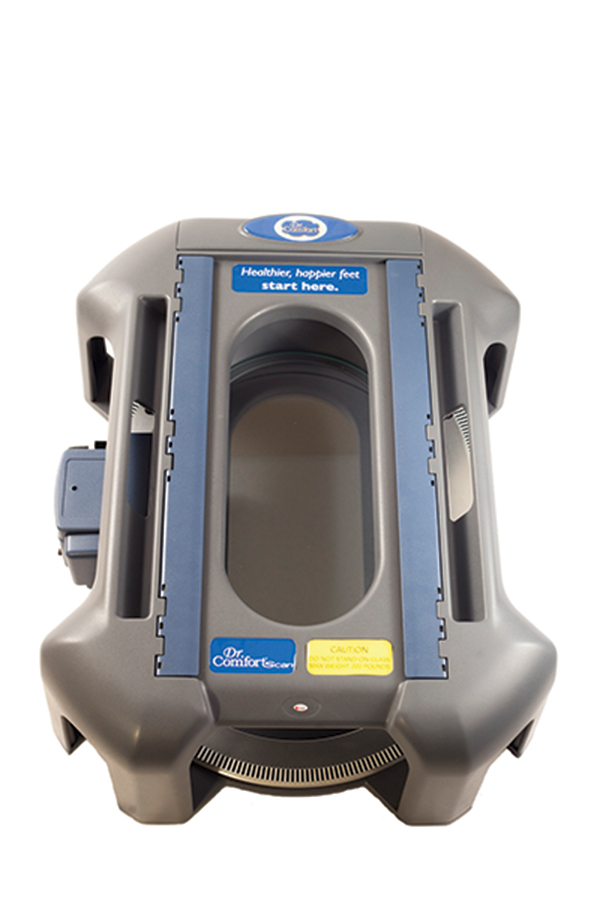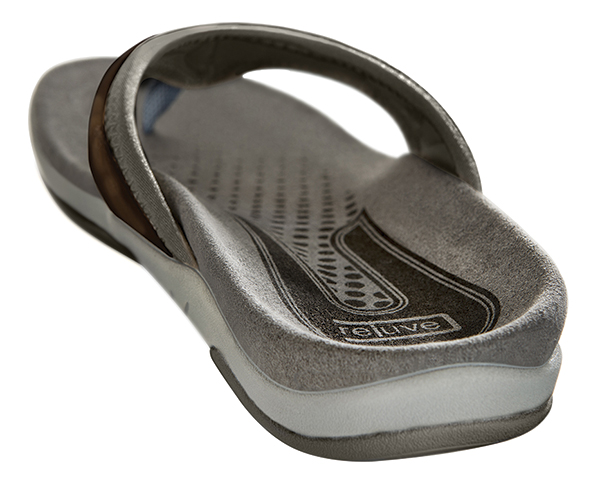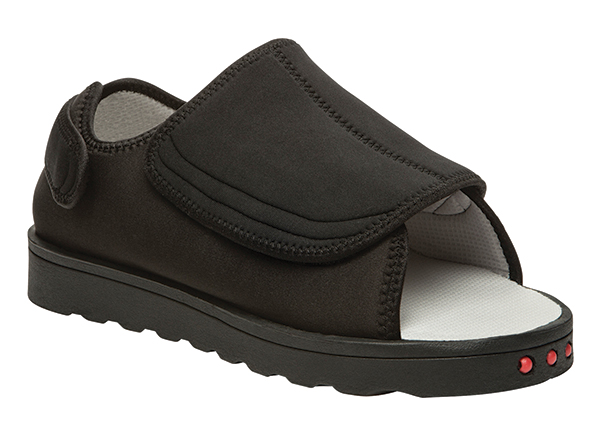Baby boomers looking for therapeutic footwear today are part of the original Nike generation and have spent much of their lives wearing athletic shoes. They want to be fashionable, and therapeutic shoes now meet that desire with a range of options from running and court styles to walking shoes.
Baby boomers now entering the market for therapeutic shoes are driving an emphasis on appearance as well as benefits.
“Baby Boomers are not willing to compromise on look and style,” says Cecilia Lauerman, Propét USA brand manager. “In fact, the most frequent comment we get at trade shows is ‘I want something that doesn’t look like a Frankenstein shoe or your traditional therapeutic shoe.’”
“We want to provide footwear that is good looking and healthy for their feet,” says Matthew Schwartz, executive vice president of Aetrex Worldwide. He says Aetrex’s successful and growing consumer footwear business provides lessons to guide design of the Apex therapeutic footwear line, sold through HME providers. “We bring that knowledge to bear in the styles, the kinds of leather, patterns, embellishments—they all reflect lessons we have learned in the consumer market.”
Manufacturers have worked to remove any obstacles for providers looking to enter the footwear market, Schwartz says. Apex provides an aggressive 30-day guarantee, and the dealer can return products at no charge. “The policies, programs and products all make it incredibly easy to operate this business— and it’s profitable for the dealer."
Apex has a full-time, trained sales force, available for the dealer to call upon to help educate referral sources about how the products benefit patients. Getting into therapeutic footwear isn’t complicated for HME providers, and it doesn’t take a lot of investment—just a simple display in the store and a Certified Pedorthist (C.Ped.) fitter.
It’s possible for either an employee to get certified or to have a certified fitter work in-store on a contract basis, say for a half hour on Friday afternoons, says Charles Liberge, executive vice president of sales/business development at Orthofeet. In the case of Orthofeet, there are no large inventory costs, just a fitting inventory of 25 pairs of shoes; customer orders are shipped within 48 hours. Customers can have their shoes within two or three days—and the entire investment for an HME provider could be less than $1,000.
Lighter Weight, Better Comfort
Among the product trends is a swing back from a recent emphasis on minimalism, with shoes that are now more biomechanically inclined and take advantage of newer materials. “Shoes are getting lighter and lighter, but they still feel comfortable and supportive, despite how light they are,” says Lauerman of Propét. “Older consumers who get a little unstable on their feet don’t want the extra weight.”
Propét USA has a therapeutic shoe line (A5500-coded Medicare-reimbursable) and also a retail line. Propét has launched the Rejuve line of shoes, podiatrist- designed products intended to cup the heel and hold the foot in its natural position during heel strike so the walker doesn’t over-pronate. (Pronating refers to the inward roll of the foot while walking or running; over-pronating can cause stress on the lower body that aggravates foot conditions or foot and ankle pain.) Rejuve’s spring line will include sandals and flip-flops, and a line of closed-toe shoes featuring outdoor styles and women’s slippers will debut in the fall.
 Dr. Comfort’s orthotic scanner captures more than 30,000 data points to provide a true 3-D image.
Dr. Comfort’s orthotic scanner captures more than 30,000 data points to provide a true 3-D image.
Propét is also launching AdaptaStep, a shoe that provides variable flexibility in the outsole for post-op or post- trauma patients, helping them progress to a natural gait more quickly. For those who are more sedentary and can’t wear regular shoes because of swelling, Propét’s Cronus is a stretchy neoprene-style slipper that opens completely on the top for anyone who has difficulty getting around or is recovering from an illness. Lauerman recommends HME providers stay focused on the product lines that appeal to customers coming into their store, emphasizing shoes that are supportive and comfortable and that offer more athletic and casual styles suited to wear for long hours. Until they get a handle on local customer preferences, providers should limit their options to a few styles—maybe an all-around walking shoe and the Cronus slipper if the customer base uses wheelchairs or tends to be sedentary.
Highlighting Features and Benefits
Education is an important aspect of building footwear business for an HME provider. Customers have to be educated about why it’s important to have shoes that properly fit their feet and offer various orthopedic features and benefits, says Liberge. Customers also need shoes that fit their lifestyles, whether they’re sandals, boots, sneakers, shoes or slippers.
The Medicare benefit for diabetic shoes covers one pair of shoes and three pairs of diabetic inserts per year. A lucrative cash sale opportunity is to sell customers additional pairs of shoes, at around $140 each, because everyone needs more than one pair. The cash price tag is on par with a typical premium shoe (and with a retail margin above 50 percent), Liberge notes.
There is also unrealized opportunity related to reimbursement. Liberge notes that physicians have to be involved in the process of getting Medicare reimbursement, and sometimes they have to be chased down to get the appropriate information. Perhaps because of the extra effort, only about 1.5 million of the 6 million patients eligible for Medicare reimbursement take advantage of the diabetic shoe benefit.
“We have created an entire consumer education program, including a booklet that can be used as a marketing piece, walking customers through the basics of proper fit and foot care and the reimbursement process,” says Liberge. He recommends providers include the booklet with every product they sell, leave it behind on deliveries and/or offer it at the store. Orthofeet specializes in the diabetic market, with about 99 percent of its products Medicare-approved diabetic and custom inserts and diabetic hosiery. Although Medicare-approved, the shoes are also sold through retail venues, major websites and catalogs.
 Propét’s Rejuve line of shoes are designed to cup the heel and hold the foot in its natural position.
Propét’s Rejuve line of shoes are designed to cup the heel and hold the foot in its natural position.
Liberge suggests grouping diabetic products together, including diabetic supplies and accessories as well as footwear, hosiery, inserts, etc. to create a “story.” “The ability to grow depends on selling more to the current customer base and attracting new customers.” He says footwear can be a differentiator for an HME provider in the local market.
Fashion-Forward Therapeutics
Aetrex was a pioneer in many orthotic categories. Under the Apex brand, the company provides a variety of Medicare- reimbursable therapeutic footwear, custom orthotics and heat-moldable orthotics. Cash sale opportunities include diabetic socks with flat seams and copper woven into the fibers. Apex offers a new line of fashion-forward therapeutic footwear called Pedals, which include 5/16 inch of removable depth. The shoes feature injection- molded ethylene-vinyl acetate (EVA) slip-resistance and super-light outsoles. The uppers are full-grain leather and can accommodate custom or heat-moldable orthotics. The outsoles can also be modified to accommodate various braces and lifts. The company’s T2000 is a stretchable, therapeutic shoe that accommodates all foot shapes. “The key footwear companies have been focusing resources to create operational efficiencies for HMEs,” Schwartz says. Apex offers a fitting tower display that showcases the shoes and can be used to fit the patient, but doesn’t take up a lot of floor space.
Increasing Awareness
Although professionals may view diabetic shoes as a medical item, patients tend to view them as part of their wardrobe, says Greg Karian, marketing director for Dr. Comfort, a DJO Global brand. New Dr. Comfort products include a beautiful women’s classic heels collection (coded A5500). “For the right patient, these are the most comfortable heeled shoes most women have ever worn,” says Karian, who notes that heels are not ideal for every patient with diabetes.
Dr. Comfort’s Comfort Relief Channel provides forefoot pressure relief and the BOA closure system allows greater adjustability. Dr. Comfort is a leading manufacturer of diabetic footwear, offering a complete line of shoes, inserts, slippers, sandals, socks and compression wear.
This year, Dr. Comfort is launching a new orthotic scanner, which will save as much as four days in shipping by sending the files to the lab electronically versus using a foam impression box. Tablet-based and fully wireless, the laser scanner captures more than 30,000 data points to provide a true 3-D image. The tablet also encourages greater interaction with and education of the patient. The new scanning process will apply both to current diabetic inserts and to a new line of functional orthotics. Also, greater efficiencies have enabled Dr. Comfort’s lab to ship inserts the next business day after receiving an order. Combined, the processes will enable HME providers to get custom inserts delivered within three to five days after their first visit with a patient.
 Propét’s AdaptaStep shoe provides variable flexibility in the outsole for post-op patients.
Propét’s AdaptaStep shoe provides variable flexibility in the outsole for post-op patients.
Also new in 2014 is a Dr. Comfort athletic line, featuring great colors, a virtually seamless lining, and super-lightweight construction, also coded A5500. “If we can provide patients a pair of shoes that’s not only part of self-managing their disease but also part of the wardrobe they love, it can help them become more positive about the necessary life changes. Yes, living with diabetes can be challenging—but you get to receive a great-looking pair of shoes that are really comfortable.”
A major initiative for Dr. Comfort this year is to increase awareness of diabetic footwear among primary care physicians (PCPs). Building strong relationships can help ensure that PCPs provide the right documentation upfront to support an HME provider in the event of an audit. “Our initiative is aimed at helping physicians understand the benefits of professionally fit prescription diabetic footwear, as well as the documentation they need to provide,” says Karian. There is also an added benefit of additional referrals. Karian says that PCPs are hungry for information on the topic of diabetic shoes, realizing that foot health complications are often a concern and can be avoided. “Many will look at their diabetic patients’ feet during regular exams,” he says. “[Prescribing] diabetic footwear is something they can do to help many of their at-risk patients today—before more serious complications develop. We just need to make them aware that it’s out there.”
Many PCPs and the greater medical community just don’t believe diabetic shoes are “real medicine,” says Karian. They may suggest their patients wear properly fitting shoes, but may not be aware of the specific benefits of professionally fit diabetic shoes and inserts. “If we’re going to get PCPs to refer more patients for diabetic footwear, we must convince them to change their protocols to automatically refer patients who qualify. We need strong evidence to help get the word out.”
Common sense points to the preventative care benefits of diabetic shoes, and Dr. Comfort is sponsoring a retrospective health care economic study on diabetic footwear to quantify the benefits. The study is based on a large database of historical claims, analyzing two otherwise statistically similar groups—those who are prescribed diabetic shoes and inserts and those who aren’t. The study will follow both groups for two years to compare the occurrences of ulcerations, amputations, etc. “The initial data we’re looking at is very encouraging,” says Karian. “We estimate less than 20 percent of the patients who have a medical need for diabetic footwear [and would qualify for Medicare reimbursement] are actually getting their shoes and inserts.”
The coming wave of baby boomers entering Medicare expands the potential to help more people with diabetic footwear, he adds.




